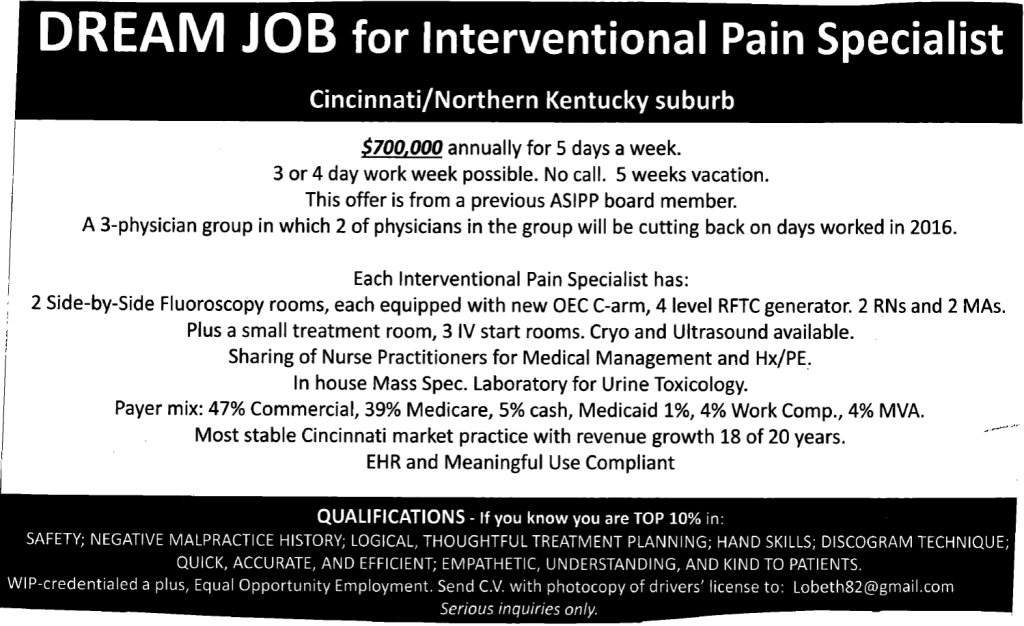The pushback on opioids has accelerated dramatically; every day there’s at least one major announcement about states, the Feds, or other entities taking major steps to attack the overuse of opioids.
We are starting to see some progress. Perhaps most noticeably, a few weeks ago the CDC published draft guidelines re the use of opioids for treating chronic pain.
Unsurprisingly, the pain industry wasn’t happy. They’ve penned letters to CDC officials and Congress, with one complaining: “a lobbying organization that seeks to reduce the prescribing of opioids appears to have played a significant role in developing the guidelines.”
Allow me a moment to pick my jaw off the floor. This is the height of hypocrisy.
This is coming from an industry that has used the billions it has made from selling opioids to:
- lobby state and federal elected officials and regulators,
- pack ostensibly unbiased review panels with drug company shills,
- fund “research organizations” that published biased research supporting opioids, and
- brilliantly and effectively promote the use of this incredibly dangerous and damaging drug.
I’m just stunned at the unmitigated gall of these people.
CompPharma (the work comp PBM advocacy organization of which I am president) has joined with the National Safety Council, Physicians for Responsible Opioid Prescribing, American Society of Addiction Medicine, National Coalition Against Prescription Drug Abuse and several other groups to support the DC guidelines.
The human cost of opioids is a constant and terrible reminder of the impact the opioid promotion industry has on each of us.
Yesterday the estimable Steve Feinberg MD sent one of his periodic emails re interesting issues related to work comp and the delivery of care in comp.. This one was a column by Bob Beckel, an editorialist who recounted how he had to check himself into rehab after a mere eight weeks post-op care involving OxyContin and Percocet had addicted him to the stuff.
Truly frightening. And very common.
A truly awful side effect of the rampant overprescribing of prescription opioids has been the explosive growth in heroin use. When patients can’t get prescription opioids, those addicted or dependent may well turn to illicit versions of opiates, namely heroin.
myMatrixx’ Phil Walls RPh has written an excellent synopsis of the history and current status of heroin. Detailed, thorough, readable; download and read on your next flight.
Perhaps the most trenchant observation appeared a couple weeks ago in an editorial in the New York Times entitled “How Doctors Helped Drive the Addiction Crisis”. Here’s Dr Richard Friedman’s concluding paragraphs:
WHAT is really needed is a sea change within the medical profession itself. We should be educating and training our medical students and residents about the risks and limited benefits of opioids in treating pain. All medical professional organizations should back mandated education about safe opioid treatment as a prerequisite for licensure and prescribing. At present, the American Academy of Family Physicians opposes such a measure because it could limit patient access to pain treatment with opioids, which I think is misguided. Don’t we want family doctors, who are significant prescribers of opioids, to learn about their limitations and dangers?
It is physicians who, in large part, unleashed the current opioid epidemic with their promiscuous use of these drugs; we have a large responsibility to end it. [emphasis added]
Kudos to Gov Charlie Baker (R) of Massachusetts. Gov Baker is calling for a strict limit on initial opioid prescriptions throughout his state. Of course several docs are protesting this, noting problems of access for patients who need the medications. It would be even better if these docs noted the problems inherent in opioid prescribing; perhaps they did but the reporter didn’t publish those comments… (thanks to Jake for the tip!)
Finally, there are many, many pieces and parts to ACA, including significant funding for clinical research, patient outcomes research, and research into improving the delivery of care. The Patient-Centered Outcomes Research Institute just closed it’s request for proposals for research into Clinical Strategies for Managing and Reducing Long-Term Opioid Use for Chronic Pain.
There’s nothing more important in the work comp world than this issue.

